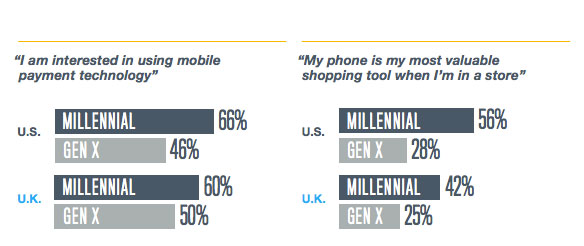
Omnichannel commerce is a hot topic, with retailers like Walgreen’s and Sephora leading the way in developing innovative in-store digital, mobile experiences and seamless content across touchpoints.
Omnichannel experiences are particularly important to Millennials — far more than Gen X. Razorfish’s 2015 Global Digital Marketing Report(click for free, ungated access) suggests 3 key reasons:
- Mobile dominates the Millennial shopping experience. Mobile is key to the Millennial’s world, and will only become more indispensable as mobile payment technologies push forward.
- Millennials draw no practical distinction between online and offline. Growing up with tech, millennials don’t see a difference between online and offline “channels.” They expect technology to extend into the physical world, with information and purchase capabilities at their fingertips.
- Millennials are redefining privacy expectations. Millennials are less concerned about how brands and retailers will use their data and protect their privacy with a “combination of trust and resignation.” They understand the tit for tat, that providing information to brands is required for the personalized experiences they want.
What does this mean for brands and retailers?
One pitfall of being an experienced and intuitive marketer, UX designer or digital leader is projection. If you’re part of Gen X (born roughly between 1961 and 1981), you may conclude the minimally viable cross-channel experience is what satisfies your own digital needs. We grew up shopping in malls without the pocket Internet, personalized retail email, social shopping and Google.
If your target market includes Millennials, don’t underestimate the digital divide between generations.
Here are a few tactics you can use:
Include millennials in your decision making both internally on your UX teams, and externally in your surveys and focus groups.
Collect birthdate information in your checkout forms and customer account data. Use this to segment and track device and omnichannel services, mobile payments, beacon use, etc across generational cohorts.
Adopt app-like experiences where possible. I’ve referenced this example numerous times, but eBags’ Tinder-like product discovery feature “Obsession” captures the new convention of swiping right or left to like or dislike, just like the popular dating app.
Other native mobile features like GPS, voice/image input and device pairing may also help you tailor to the wants and needs of the Millennial shopper.
Offer mobile payment and customer service options, such as SMS and Facebook Messenger options, which Millennials may prefer over email and telephone service.
If you’re looking for guidance in your omnichannel technology and experience strategies, we have 2 current resources for you:
- The2015 Advanced Commerce Maturity Scale is a self-assessment tool that provides a Meyers-Briggs-like profile of your company, with descriptive and visual results to help you fully understand your current level of ecommerce maturity relative to the current standard of excellence. The tool includes guidance on how companies like yours are/can move up the curve in customer experience, digital strategy, technology and organizational dynamics, short and long-term.
- The first of a series, our ebookThe New Customer Journey: A Convergence of Content, Context, Channels and Commerce is available for free download. The book covers the what and why of experience-driven commerce, its impact and how to know if your company is ready.

Image credit: CC by Pabak Sarkar.



